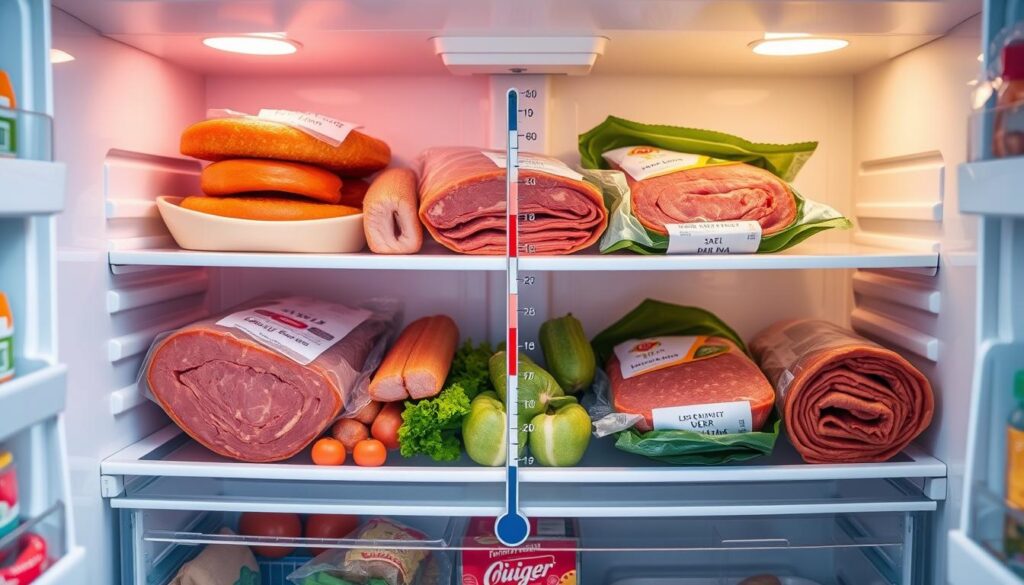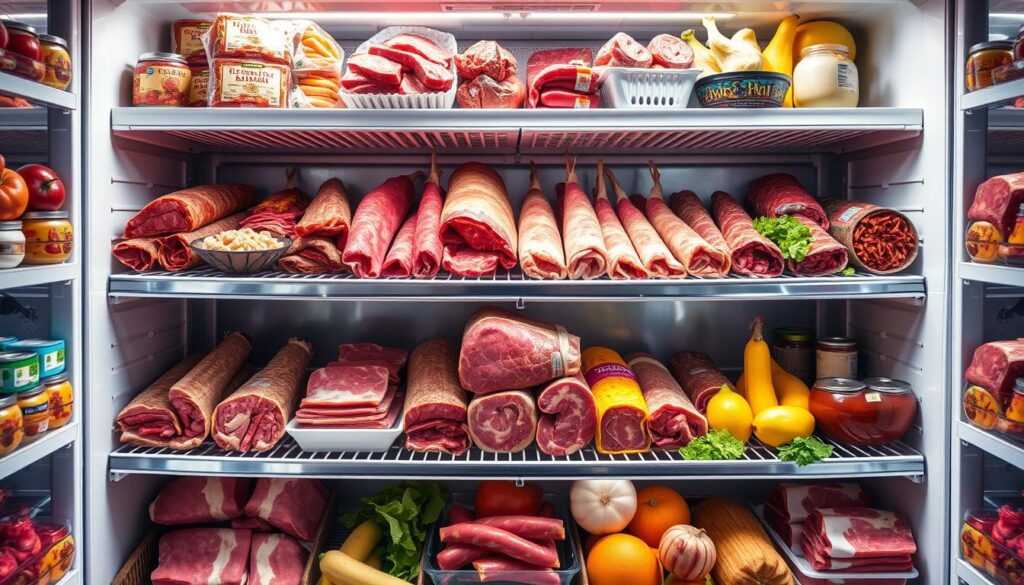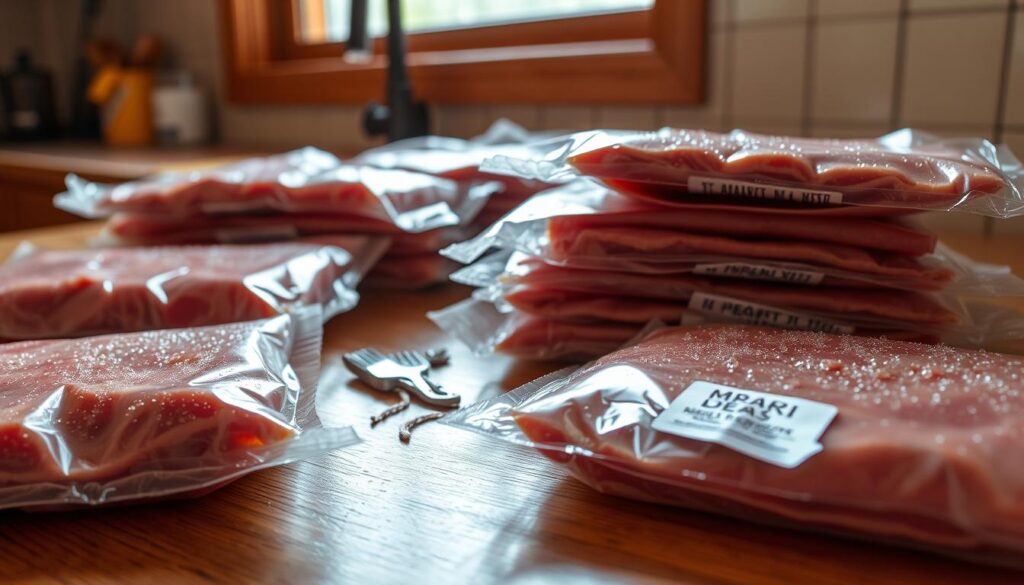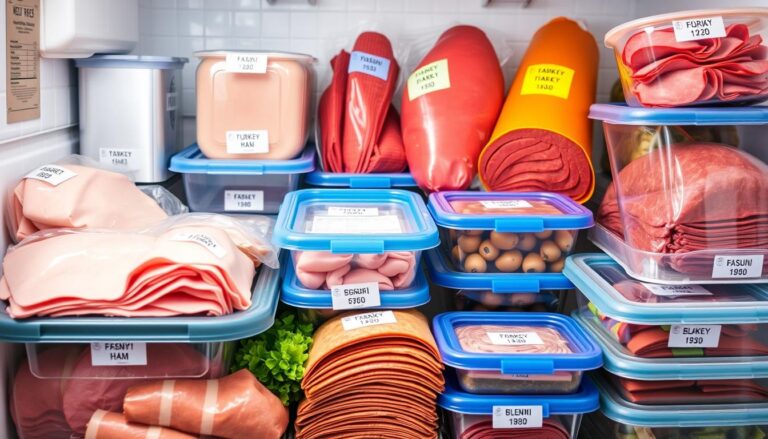Have you checked on that deli meat in your fridge lately? We often grab deli meats for an easy meal but find ourselves asking, “how long is deli meat good for?” Whether you’re building the perfect sandwich or trying a new meatloaf recipe, knowing how to store deli meat is vital. It ensures both taste and safety. Deli meat doesn’t have a simple shelf life answer, and you might find it surprising.
The freshness of deli meat begins to fade as soon as it’s sliced. Though preservatives like sodium nitrate and salt help, how you store it is crucial. Always refrigerate it right after buying to stop bacteria growth. Even the best-smelling sliced meats last only three to five days in the fridge once opened, just like their sealed versions.
Key Takeaways
- Assessing deli meat shelf life is essential for both food quality and safety.
- Storing deli meat properly extends its freshness and reduce waste.
- Preservatives in deli meat play a significant role in how long it remains good for consumption.
- The lifespan of deli meat changes once the package has been opened.
- Understanding storage recommendations can enhance your kitchen practices.
Understanding Deli Meat and Its Popularity
Deli meat is loved for its ability to fit into many cold cuts recipes. It’s a must-have in American homes. You can use it in everything from simple sandwiches to fancy starters. Its popularity comes from being both versatile and convenient for those with busy lives.
It’s important to keep these meats fresh for safety and taste. Good storage is crucial. Put it in the fridge right after you buy it and use tight containers. This keeps air and germs away.
Knowing why deli meats are popular can help you choose and store them better. Here are some reasons people love them:
- They save time. Deli meats mean you can make quick meals, great for busy people.
- They come in many flavors. You can find a wide variety, so everyone’s happy.
- They’re versatile. You can use them not just in sandwiches but in salads, pizzas, and fancy meals too.
For more ideas on using deli meats, look into cold cuts recipes. These tips not only make meal planning fun but also help your deli meats last longer.
How Long Is Deli Meat Good For?
Knowing how long deli meat lasts is key for meal safety and quality. If you have pre-packaged or freshly sliced deli meat, it’s important to know how long it’s good for after the sell by date. Learning how storage conditions affect its lifespan helps reduce food waste and keep meals safe.

The Lifespan of Unopened Pre-Packaged Deli Meat
Unopened pre-packaged deli meat is great for quick meals. Its shelf life largely depends on preservatives and the packaging method. It may last up to two weeks in the fridge, says the USDA. This assumes it is kept at a steady, cool temperature.
Shelf-Life of Opened Deli Meat in the Refrigerator
Opening the package shortens the deli meat’s expiration period. Opened, both pre-packaged and freshly sliced deli meats are good for three to five days. Key to longer life is tight wrapping and immediate refrigeration to avoid bacteria.
Comparing Freshly Sliced vs. Packaged Deli Meat
Freshly sliced and opened packaged deli meats have similar life spans—three to five days if kept cool. However, the shelf life of sliced deli may vary because of its lower fat and different handling.
| Type of Deli Meat | Unopened Shelf Life | Opened Shelf Life |
|---|---|---|
| Pre-Packaged | Up to 2 weeks | 3-5 days |
| Freshly Sliced | N/A | 3-5 days |
| Sliced Deli Turkey | Up to 2 weeks | 3-5 days |
Looking for tasty ways to use deli meat before it spoils? Check out various safety tips and recipes. They can improve both your meal’s taste and safety.
The Role of Preservatives in Deli Meat Longevity
Looking into how deli meat preservatives aid in extending deli meat shelf life reveals a dual purpose. These ingredients are key in keeping deli meat both high-quality and safe to eat. Sodium nitrate and salt do more than just make these foods tastier. They are essential for making deli meats last longer.
How Sodium Nitrate and Salt Affect Shelf-Life
Sodium nitrate is a strong preservative. It stops bacteria from growing and keeps deli meats looking and tasting good as an antioxidant. Salt pulls water from the meat and bacteria, which stops bacteria from growing. Sodium nitrate and salt work together to maintain the quality and safety of deli meats.
Pathogenic and Spoilage Microorganisms in Deli Meat
Microorganisms like Listeria, Salmonella, and E. coli can spoil food and cause illnesses. Using certain preservatives helps to lessen these dangers in deli meats. This is key for keeping the food safe and high quality.
| Preservative | Function | Impact on Microorganisms |
|---|---|---|
| Sodium Nitrate | Antioxidant, color preservation | Inhibits growth of harmful bacteria |
| Salt | Moisture absorption | Creates inhospitable environment for bacteria |
| Both | Combined preservative effect | Enhances overall meat safety and longevity |
Best Practices for Storing Deli Meat
Keeping deli meats fresh and safe needs following certain storage rules. These include keeping them cool and away from the temperature danger zone. Following these deli meat storage guidelines is key to keep them fresh. It also stops foodborne illnesses. Let’s look at the best ways to handle these products once you’ve bought them.
Refrigeration Immediately After Purchase
Right after you bring deli meats home, put them in the fridge. This is one of the best practices for storing deli meat. Keeping them cold slows down the growth of bacteria. These bacteria can spoil the meat and make people sick.
Avoiding the Temperature Danger Zone
You shouldn’t leave deli meats out at room temperature for over two hours. This time drops to just one hour if it’s above 90 degrees Fahrenheit. The temperature danger zone is between 40 and 140 degrees Fahrenheit. Staying away from this zone is crucial. It stops bacteria from growing fast and causing illnesses.

| Storage Factor | Guideline | Risk |
|---|---|---|
| Immediate Refrigeration | Refrigerate deli meats immediately upon purchase. | Prevents bacterial growth. |
| Room Temperature Exposure | Limit to less than 2 hours (1 hour in temps above 90°F). | Reduces risk of entering the temperature danger zone. |
| Temperature Monitoring | Store between 34°F and 40°F. | Keeps the meats out of the temperature danger zone. |
What Is the Temperature Danger Zone?
Understanding the temperature danger zone is key, especially when we talk about deli meat food safety. It’s a range from 40 to 140 degrees Fahrenheit. In this zone, bacteria grow fast and can cause illnesses. Keeping deli meats out of this zone is vital for their safety and freshness.
Why does this range matter? Below 40°F, bacteria grow slowly. Above 140°F, heat can kill most bacteria. So, it’s important to keep deli meats cold or hot enough to stay safe.
| Temperature Range | Risk Level | Recommended Action |
|---|---|---|
| Below 40°F | Low | Safe for storage |
| 40°F to 140°F | High | Avoid this range |
| Above 140°F | Low | Safe for serving |
For top deli meat food safety, watching and managing temperatures is crucial. Being careful keeps the quality of deli meats high. It also guards against health risks from bacteria in the temperature danger zone.
Optimizing Refrigerator Conditions for Deli Meat
Keeping your fridge in the right condition is key to ensuring food safety. It also keeps deli meat fresh longer. It’s important to place and check on your deli meat carefully for proper refrigerator storage for deli meat.
Finding the Coldest Part of Your Fridge
To keep deli meat fresh, store it in your fridge’s coldest spot. The coolest area is usually the back of the lower shelves. This spot stays cold because it’s away from the door, which is often opened and closed.
Keeping your deli meat here helps keep it fresh.
Monitoring Temperature With External Thermometers
Using external refrigerator thermometers regularly is smart. It makes sure your fridge’s temperature stays at or below 40 degrees Fahrenheit. Keeping the temperature right stops harmful bacteria from growing on deli meat.
| Refrigerator Zone | Typical Temperature | Suggested Storage |
|---|---|---|
| Door | Around 42°F | Condiments, juices |
| Top Shelf | 38-40°F | Dairy, cooked foods |
| Lower Shelf (back) | 34-36°F | Deli meats, fresh meat |
| Vegetable Drawer | 40-42°F | Fruits and vegetables |

Handling Deli Meat to Maintain Freshness
Right from the start, handling deli meat properly is key. Be sure to pick packages that are sealed well and feel cold. After you bring it home, keep the deli meat cold. Also, use clean tools when you touch it. This helps it stay fresh. You’ll want to follow these important deli meat freshness tips. They help stop it from going bad and keep it tasting great.
- Always use clean hands or tongs when handling deli meat.
- Keep the meat wrapped tightly in plastic or within its original packaging, and use a resealable bag or airtight container if transferring to another package.
- Place deli meat in the coldest part of the refrigerator, typically at the back, far from the door.
- Avoid cross-contamination by keeping deli meat separate from other uncooked foods.
Following these steps is good for both safety and the taste of your deli meats. Don’t forget, you can also check if it’s still good by looking at it. If the color is bright and there’s no slimy feel, then it’s fresh.
| Handling Tip | Reason | Expected Outcome |
|---|---|---|
| Use of clean utensils | Prevents introduction of bacteria | Extends freshness |
| Avoid direct handling | Keeps the meats uncontaminated | Reduces risk of spoilage |
| Proper refrigeration | Maintains optimal temperature | Preserves taste and texture |
| Separation from other foods | Prevents cross-contamination | Enhances safety and cleanliness |
Using these handling deli meat tips makes your deli items more enjoyable. Keep these deli meat freshness tips in mind. Do this when you shop next time. This ensures you get the best taste and quality from your choices.
Varying Shelf-Life of Different Deli Meats
Deli meats have different shelf lives, from salami to turkey. Each type has its own deli meat longevity, based on how it’s prepared and its preservatives. Knowing the shelf life of your favorites helps make safer, tastier choices.

Fermented vs. Dried Deli Meats
Pepperoni and salami, which are fermented, go through a curing process. This process enhances their flavor and makes them last longer. The fermentation is key to how long is deli salami good for, letting it stay good for longer. Dried meats, like capicola and prosciutto, are air-dried to lower moisture. This stops bacteria from growing, which makes them last longer too.
Indefinite Refrigeration of Certain Deli Meats
Some deli meats, like unopened pepperoni and Genoa salami, can be refrigerated for a very long time. This is according to USDA guidelines. This long shelf life relies on keeping them cool at all times. Opening them or changes in temperature can reduce the deli roast beef shelf life. It also affects how long is sliced deli turkey good for.
Freezing Deli Meat for Extended Preservation
Freezing deli meat is a great way to extend its shelf life. Keep your freezer at 0°F. This keeps it safe and fresh longer. This method helps prevent freezer burn and keeps the taste and texture good.
Right packaging is key for freezer storage of deli meat. Deli meats must be wrapped well in materials safe for the freezer or vacuum-sealed. This prevents air from getting in. Air leads to freezer burn and makes the meat quality worse.
Proper Freezer Settings and Packaging
Good control of freezer settings and wrapping deli meats well make freezing them easier. For top tips on freezing and packaging, check out this guide on extending deli meat shelf.
The Impact of Freezer Burn on Deli Meats
Freezer burn damages the taste and texture of deli meats. Knowing what causes freezer burn is important for storing meats right. Fats and oils in the meats react with air, causing oxidation. This changes the flavor and dries out the meat.
| Storage Method | Expected Shelf Life | Impact on Quality |
|---|---|---|
| Refrigeration (Unopened) | Up to 2 weeks | Minimal quality loss |
| Refrigeration (Opened) | 3 to 5 days | Moderate quality loss |
| Freezing | 1 to 2 months for best quality | Can cause freezer burn if not properly sealed |
For tips on freezer settings and reducing freezer burn, explore strategies here.
Understanding Thawing Practices and Microbial Growth
Handling deli meats safely requires knowing how to thaw and understanding microbial growth in meat. Freezing is common to keep deli meat longer. But, thawing it right is key for safety.

Thawing deli meats the wrong way can speed up microbial growth. This makes freezing pointless. It’s crucial to thaw in a way that prevents bacteria from thriving.
Keep thawing temperatures in check to suppress bacterial growth, ensuring that deli meats remain safe to eat.
Here’s a safe guide to thaw deli meats:
- Refrigerator Thawing: Move the deli meat from freezer to fridge and let it thaw for hours or overnight. This method keeps the meat cold, stopping microbial growth in meat.
- Cold Water Thawing: Put the deli meat in a leak-proof bag and soak it in cold water. Change the water every 30 minutes. This is quicker than fridge thawing but needs careful temperature watch.
- Microwave Thawing: For a quick thaw, use microwave. Put the meat on defrost setting and cook it right after to avoid bacteria growth.
| Method | Time Required | Temperature Control |
|---|---|---|
| Refrigerator Thawing | Several hours to overnight | Very Good |
| Cold Water Thawing | 1-2 hours | Good (requires monitoring) |
| Microwave Thawing | Minutes | Poor (requires immediate cooking) |
No matter the thawing method, keep deli meat thawing temperature in mind. And, avoid letting meat stay in the danger zone (40°F to 140°F) where bacteria grow fast. Proper thawing keeps deli meats safe and good.
Visible Signs of Deli Meat Spoilage
Knowing how to spot signs of spoiled deli meat is crucial for food safety. Spoiled deli meats can cause health problems. Recognizing these signs helps avoid these risks.
Checking for Changes in Color and Texture
A key sign of deli meat spoilage is change in color and texture. Fresh deli meats look bright and feel firm. If the meat turns dull, grayish, or slimy, it’s not safe to eat. Mold, appearing as white or green fuzz, means the meat is spoiled and must be thrown away.
The Risks of Tasting to Determine Safety
It’s risky to taste deli meat to see if it’s safe. Risks of eating spoiled deli meats include harmful bacteria like Listeria. These bacteria can cause serious illnesses, especially in people at high risk.
To eat deli meats safely, always check the expiration date and store them right. When unsure, better to discard them. For safe meat handling/cooking tips and tasty recipes, visit this resource.
| Sign | Indication |
|---|---|
| Change in Color | Meat appears grayish or pallid |
| Texture Change | Development of slimy or sticky surface |
| Odor | Unpleasant or sour smell |
| Visible Mold | White or green fuzzy spots |
Specific Risks Associated With Spoiled Deli Meat
Eating spoiled deli meat is risky because of harmful bacteria like Listeria. These germs can be very dangerous. They are especially harmful to pregnant women, young kids, and those with weak immune systems. Knowing how to reduce risk is key to staying healthy.

One big worry is Listeria monocytogenes in bad food, such as deli meats. This can cause listeriosis, a very serious sickness. Symptoms might be mild like the flu or severe, leading to meningitis or septicemia.
Let’s talk about the dangers of deli meat health risks:
- Gastrointestinal infections causing intense dehydration and diarrhea
- Becoming more open to other infections after Listeria
- Possible continuing issues like reactive arthritis, also known as Reiter’s syndrome
Proper handling and storage of deli meats are crucial. They stop Listeria and other bacteria from growing. Being aware and careful helps protect our health.
For tasty dishes that are also safe, use deli meats handled with care. These steps make meals safe and enjoyable. Check out a safe and tasty Italian meatloaf recipe here.
| Effect | Caused by | Risk group |
|---|---|---|
| Gastrointestinal distress | Listeria, other bacteria | All consumers, particularly immuno-compromised |
| Neurological damage | Listeria | Pregnant women, Aged |
| General weakness, fever | Bacterial toxins | Young children, Aged |
Staying informed about deli meat health risks helps us to eat deli meats safely. It also lowers our chance of getting sick from Listeria in deli meats.
Guidelines for Freezing and Refrigerating Foods
Following the right food storage guidelines is important to keep deli meats safe and fresh. Knowing how long deli meat lasts helps avoid deli meat expiration and food spoilage. Whether you’re chilling or freezing, the correct method can make a big difference.
Consider these tips for storing deli meats:
- Always put deli meats in the refrigerator right after buying or using them.
- To keep them safe, deli meats should be stored at or below 40 degrees Fahrenheit.
- For freezing, use deli meats within one to two months to keep them good.
Freezing deli meats helps them last longer than their usual fridge life. Here’s a simple table for how long to store various deli meats:
| Type of Deli Meat | Refrigerator (40°F or below) | Freezer (0°F or below) |
|---|---|---|
| Pre-packaged, unopened | 2 weeks | 1-2 months |
| Opened | 3-5 days | 1-2 months |
| Freshly sliced from deli | 3-5 days | 1-2 months |
While freezing can keep deli meat from spoiling longer, it may change its texture and taste. To avoid freezer burn and keep the best quality, wrap the meat well in airtight packaging.
To keep your deli meats safe and tasty, carefully follow these food storage guidelines. Proper care and storage are essential for making your deli meats last longer, ensuring they stay fresh and safe for eating.
Conclusion
We’ve learned a lot about keeping deli meats fresh and key storage tips. Knowing how long deli meats last helps people make better choices when buying and storing them. We also looked at how preservatives like sodium nitrate help keep meats fresh longer and what to do to stop bacteria from growing.
It’s really important to refrigerate deli meats the right way and handle them carefully. This keeps them safe and tasty. Using the freezer right can also help keep deli meats fresh longer when needed.
Enjoying deli meats safely depends on paying close attention and following storage advice. Knowing what keeps deli meat fresh lets people enjoy their food without worry. Follow these tips to make sure your deli meats stay delicious and safe to eat.
FAQ
How long is deli meat good for when refrigerated?
Pre-packaged deli meat lasts up to two weeks in the fridge if unopened. Once opened, eat it within three to five days. This applies to both pre-packaged and freshly sliced meats.
Does the type of deli meat affect its shelf life?
Indeed, shelf lives vary among deli meats. Fermented and dried meats, like salami, last longer. Unopened, they can last almost indefinitely.
Freshly sliced meats like turkey need to be eaten sooner. They last three to five days once opened.
Can you freeze deli meat?
Yes, freezing extends its life. Use it within one to two months for the best quality. Wrap it well to avoid freezer burn.
What is the temperature danger zone for deli meat?
The danger zone is 40 to 140 degrees Fahrenheit. This range speeds up bacterial growth. Keep meat out of this range for over two hours.
Are preservatives in deli meat important?
Preservatives, like sodium nitrate, are crucial. They stop harmful bacteria, keeping the meat safe and fresh longer.
What are the signs that deli meat has spoiled?
Look for changes in color, smell, and texture. Bad meat may smell off, change color, or get slimy. When in doubt, throw it out.
How should deli meat be stored in the refrigerator?
Keep it in the fridge’s coldest part, usually the back. Seal or wrap it tightly. Ensure the fridge is at or below 40 degrees Fahrenheit with a thermometer.
How do you handle deli meat to maintain freshness?
Handle it with clean hands or utensils. Only touch what you’ll use. Refrigerate right up until use and seal it well afterward.
What should you do if you’ve eaten spoiled deli meat?
If sick after eating bad deli meat, get medical help. Watch for nausea or fever. High-risk groups should talk to their doctor.
How do you properly thaw frozen deli meat?
Always thaw it in the fridge to stay safe. Avoid room temperature to keep it out of the danger zone.



